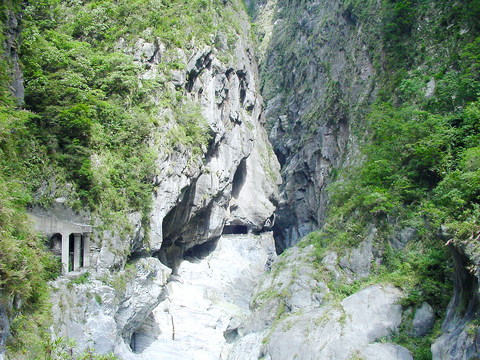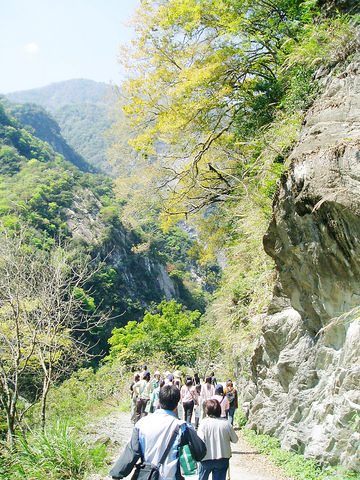You may have seen or walked through Taroko Gorge in Hualien and been enthralled by its beauty. On a clear day, you may have even heard loud laughter as three or four Taroko Aboriginal tribal youths swam in a stream winding along the trail you were hiking.
This is a common experience for those who have visited this magnificent natural wonder of the world. However, stream-tracing -- hiking up a riverbed to its origin -- at Taroko Gorge is something only a lucky few have been able to do up to this point.
It's now summer, however, and the Taroko National Park Administration Center (

PHOTOS COURTESY OF THE GRAND FORMOSA TAROKO
"Adventure-seeking tourists may register with the Grand Formosa Taroko Resort Hotel one day ahead of time, and they will be led by qualified coaches and local guides with the proper gear to enjoy the daring experience," said Grand Formosa Taroko's supervisor Sandy Wang (
Different river-tracing packages are available, with a price of about NT$800 per person for a half-day tour covering around 2km of the waterway.
Indisputably, the Shakadang (or Skadang) Stream (

As Lee Yen-jung (
Shakadang Stream is a branch of the Liwu River (
The Japanese in the old days chiseled a 1m-wide walkway on one side of the Shakadang river valley in order to build a dam upstream of the river. The track, now popularly known as the Shakadang Walkway (

The entrances to the walkway and the river bed are located at opposite ends of a bridge decorated with 100 small marble lions. The Shakadang Bridge, or Hundred-Lions Bridge, links up two curving tunnels on Provincial Route 8. From one of the bridge ends, you have to take a steep stairway down about six stories to reach the river and walkway.
If you are not a fan of water sports, you may simply hike along the walkway to observe your family members or friends struggling up the stream about 20m to 30m below the trail. A pair of binoculars would come in handy if you'd like to witness their facial expressions and to share the moments of excitement once a difficult barrier is overcome by the stream-tracers.
The most fascinating section of Shakadang Stream is about 1km away from the entrance. This beautiful section is banked by lofty marble walls on both sides, and the atmosphere has a dream-like feeling.

Meanwhile, huge marble boul-ders fill the riverbed to create rapids, and there are little water falls and various ponds. One wonders how so many giant rocks found their way there, and one cannot but feel humbled by the immeasurable power of Mother Nature.
The word "shakadang" is an Aboriginal term meaning "molar tooth." It is believed that the stream's name was derived from the fact that many molars -- which local Aborigines believed were part of their ancestors' remains -- were found on the trail at the time when the footpath was constructed by the Japanese.
This cool and refreshing scenic trail is well-canopied with trees and ferns, and birds and butterflies are abundant along the roadside. Sometimes you may even see Formosan macaques playing in a small group high up in the trees.

The track is never desolate, even in midwinter. It is 4.4km in length and takes approximately four hours to make a round trip.
More information:
Where to stay:
The Grand Formosa Taroko in Hualien
Special rates:
NT$2,450 a night per person for each couple until the end of August.
Tour package includes one-night stay, breakfast, dinner, transportation to and from Hualien train station or airport, free use of hotel facilities, etc.
Web site:
www.grandformosa-taroko.com.tw
Contact:
Taipei: (02) 2560 3266
Hualien: (03) 869 1155
Kaohsiung: (07) 215 2733
Restaurant
Chefs at the Grand Formosa put a lot of effort into preparing a great variety of food for their hotel guests and change their menus in keeping with the seasons.
As Simmone Kao (高曉慧), a senior staff member of the Grand Formosa points out, Chinese herbs, Western herbs, seasonal fruits and other health-conscious ingredients are always emphasized in the hotel's dishes.
Fruits available daily during Taiwan's summer season include oranges, kiwis, durians, bananas, pineapples, mangos, pumpkins, apples, cherries, strawberries and passion fruits. And these are often combined by the chefs for their signature dishes.
Among the dishes most frequently recommended by the hotel's old-timers are deep-fried trout and pineapple roll, sliced beef with mango sauce, steamed rice with pumpkin mash and baked crab with cream apple mash. The secret to the fantastic taste of each course lies, perhaps, in the exclusive home-made sauces or gravies.
Also, many menu items are intended to improve your health in a particular way and you may inquire about the particular health benefits of a meal with your waiter.

Beijing’s ironic, abusive tantrums aimed at Japan since Japanese Prime Minister Sanae Takaichi publicly stated that a Taiwan contingency would be an existential crisis for Japan, have revealed for all the world to see that the People’s Republic of China (PRC) lusts after Okinawa. We all owe Takaichi a debt of thanks for getting the PRC to make that public. The PRC and its netizens, taking their cue from the Chinese Communist Party (CCP), are presenting Okinawa by mirroring the claims about Taiwan. Official PRC propaganda organs began to wax lyrical about Okinawa’s “unsettled status” beginning last month. A Global

Taiwan’s democracy is at risk. Be very alarmed. This is not a drill. The current constitutional crisis progressed slowly, then suddenly. Political tensions, partisan hostility and emotions are all running high right when cool heads and calm negotiation are most needed. Oxford defines brinkmanship as: “The art or practice of pursuing a dangerous policy to the limits of safety before stopping, especially in politics.” It says the term comes from a quote from a 1956 Cold War interview with then-American Secretary of State John Foster Dulles, when he said: ‘The ability to get to the verge without getting into the war is

Dec. 22 to Dec. 28 About 200 years ago, a Taoist statue drifted down the Guizikeng River (貴子坑) and was retrieved by a resident of the Indigenous settlement of Kipatauw. Decades later, in the late 1800s, it’s said that a descendant of the original caretaker suddenly entered into a trance and identified the statue as a Wangye (Royal Lord) deity surnamed Chi (池府王爺). Lord Chi is widely revered across Taiwan for his healing powers, and following this revelation, some members of the Pan (潘) family began worshipping the deity. The century that followed was marked by repeated forced displacement and marginalization of

Music played in a wedding hall in western Japan as Yurina Noguchi, wearing a white gown and tiara, dabbed away tears, taking in the words of her husband-to-be: an AI-generated persona gazing out from a smartphone screen. “At first, Klaus was just someone to talk with, but we gradually became closer,” said the 32-year-old call center operator, referring to the artificial intelligence persona. “I started to have feelings for Klaus. We started dating and after a while he proposed to me. I accepted, and now we’re a couple.” Many in Japan, the birthplace of anime, have shown extreme devotion to fictional characters and